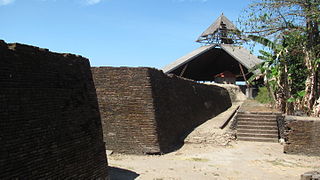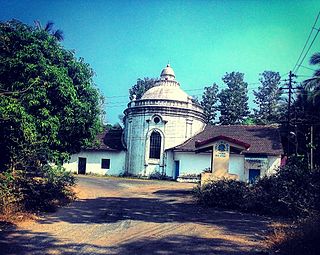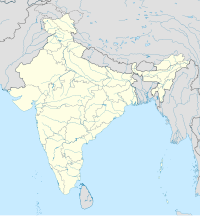
Old Goa is a historical city situated on the southern banks of the Mandovi River in the Ilhas sub-district of North Goa in the Indian state of Goa.

Ribandar(pronounced as Raaybandar) is a town in Ilhas, Goa, located between the cities of Panjim and Old Goa.

Bicholim, pronounced, also known as Divchal and Dicholi, is a town and a municipal council in North Goa district in the state of Goa, India. It is the headquarters of the Concelho (district) of Bicholim, one of seven that make up the Novas Conquistas, territories added to Goa comparatively latter than the first three of the Velhas Conquistas. The town is located about 30 kilometres from the capital Panjim. It is in the mining heartland of Goa.

North Goa is one of the two districts that make up the state of Goa in India. The district has an area of 1736 km², and is bounded by Kolhapur district and Sindhudurg district of Maharashtra state to the north and by Belgaum district of Karnataka to the east, by South Goa district to the south, and by the Arabian Sea to the west.

Chorão, also known as Choddnnem or Chodan, is an island along the Mandovi River near Ilhas, Goa, India. It is the largest among other 17 islands of Goa. It is located 5 kilometres away from the state capital, the city of Panaji and 10 kilometres away from the city of Mapusa.

The island of Divar lies in the Mandovi river in the Indian state of Goa. It is one of 6 major islands between the Mandovi and Zuari, the others being:

Tiswadi or Ilhas de Goa is a Sub-District in North Goa in the state of Goa, Konkan region, India, on which the state capital Panjim is situated, previously it was the territorial capital of both Goa and Daman.
Timoji was a privateer who served the Vijayanagara Empire and the Portuguese Empire during the first decade of the 16th century. He claimed to have been born in Goa and to have escaped the city after its conquest by the Adil Shahi of Bijapur in 1496. After his support in the 1510 Portuguese conquest of Goa, he was for a short time appointed aguazil of the city.

Corjuem Fort is a fortress situated 4 kilometres (2.5 mi) from the village of Aldona on the river island of Corjuem, Goa. It was a military fortress for the defense of Portuguese India. It is smaller than the other forts in Goa, but it gives a good view of the surrounding river and land. It is a protected monument under the Goa, Daman and Diu ancient monuments and archaeological sites and remains act.

The Diu Fortress, is a Portuguese-built fortification located on the west coast of India in Diu. The fortress was built as part of Portuguese India's defensive fortifications at the eastern tip of the island of Diu during the 16th century. The fortress, which borders on the town of Diu, was built in 1535 subsequent to a defense alliance forged by Bahadur Shah, the Sultan of Gujarat and the Portuguese when Humayun, the Mughal Emperor attempted to annex this territory. It was strengthened over the years, till 1546. The Portuguese ruled over this territory from 1537 until the Indian invasion of December 1961. Today it is a landmark of Diu and one of the Seven Wonders of Portuguese Origin in the World.
Christianity is the second largest religious grouping in Goa, India. According to the 2011 census, 25% of the resident population are Christian, while 66% are Hindu. The Christian population is almost entirely Goan Catholics, whose ancestors converted to Christianity during Portuguese rule. The Hindu population is mostly descended from migrants from other states of India, who have been arriving in Goa since the last century There is a higher proportion of Christians in Velhas Conquistas than in Novas Conquistas.

Santo Estêvão or St Estevam is an island in Ilhas, Goa, India. St Estevam is known also Jua and in the past was known as Shakecho Juvo – the isle of vegetables – known for its long, seven-ridged, light green ladyfingers. Therefore the people of Jua came to be nicknamed 'bhende'. The island is named after St. Stephen. It is one of Goa's most prosperous villages, often quoted by ex-Chief Minister Pratapsingh Rane for having a high per capita income.

São Mathias also known as Malar is a village on Divar island, Tiswadi or Ilhas, in the Indian state of Goa. The island is located 10 km upriver from Panjim.

The statue of Our Lady of Miracles, Jaffna patão is a wooden statue, now preserved in the church of São Pedro, in Bainguinim, Goa, India.

Vanxim or Capão is an island of Goa situated in the Ilhas region. One can reach here by taking a ferry from Divar. The colonial name for Vanxim was Capão. One may see a lot of houses with few villagers many of whom are fisher-folk in the area. Silveiras, Furtados, Vas, Olivera are surnames of people. Archdiocese of Goa played key role in selling the island to broker Mahendra Gaunekar who in turn sold it to Ozone corporate. Luxury hotel and Golf Course is sort to be forced upon this island but faced resistance from alert islanders and others.

Piedade is an island village located in Ilhas, a northern district in the state of Goa, India. The name comes from the Portuguese word piedade, which means "compassion". It lies 23 km east of the state capital, Panjim, between the taluks of Satari and Ponda. Other nearby villages are Amona, Volvoi, Surla, Cudnem, Betqui, and Candola.
Santa Cruz is one of the original Goa Assembly Constituency seats in the Tiswadi Taluka of North Goa District in the State of Goa. The other constituencies in Tiswadi are Panaji, Taleigao, St. Andre and Cumbarjua.

Fort Somba Opu was a fortified commercial center of the Gowa Sultanate. Its ruins are located in Makassar, South Sulawesi, Indonesia. The fort was the center of the Gowa Sultanate in the 16th-century until its destruction by the Dutch East India Company in 1669. The conquest of Somba Opu citadel was one of the most difficult campaigns the Company had ever undertaken in the East.

Naroa is a village located on the eastern tip of the island of Divar, in the Indian state of Goa. It has a population of barely a thousand people, with about 80 houses.

St Bartholomew's Church is a Roman Catholic church in Chorão, Goa, India. The Parish of St. Bartholomeu is made up of the villages of Caraim and the Passo de Ambarim. Its boundaries are the river of Mapusa to its north and west; on the opposite side of the river the parishes of Aldona and Pomburpa; the parish of Our Lady of Grace Church to the South and the river Naroa with the Parish of Pedade on the Island of Divar to its east.



















